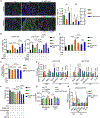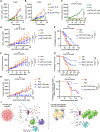MCT4-dependent lactate secretion suppresses antitumor immunity in LKB1-deficient lung adenocarcinoma
- PMID: 37327788
- PMCID: PMC11161201
- DOI: 10.1016/j.ccell.2023.05.015
MCT4-dependent lactate secretion suppresses antitumor immunity in LKB1-deficient lung adenocarcinoma
Abstract
Inactivating STK11/LKB1 mutations are genomic drivers of primary resistance to immunotherapy in KRAS-mutated lung adenocarcinoma (LUAD), although the underlying mechanisms remain unelucidated. We find that LKB1 loss results in enhanced lactate production and secretion via the MCT4 transporter. Single-cell RNA profiling of murine models indicates that LKB1-deficient tumors have increased M2 macrophage polarization and hypofunctional T cells, effects that could be recapitulated by the addition of exogenous lactate and abrogated by MCT4 knockdown or therapeutic blockade of the lactate receptor GPR81 expressed on immune cells. Furthermore, MCT4 knockout reverses the resistance to PD-1 blockade induced by LKB1 loss in syngeneic murine models. Finally, tumors from STK11/LKB1 mutant LUAD patients demonstrate a similar phenotype of enhanced M2-macrophages polarization and hypofunctional T cells. These data provide evidence that lactate suppresses antitumor immunity and therapeutic targeting of this pathway is a promising strategy to reversing immunotherapy resistance in STK11/LKB1 mutant LUAD.
Keywords: LKB1; MCT4; PD-1; T cell activation; immunotherapy resistance; lactate; lung adenocarcinoma; macrophage polarization; metabolism.
Copyright © 2023 Elsevier Inc. All rights reserved.
Conflict of interest statement
Declaration of interests F.S. has held stock ownership in BioNTech SE and Moderna Inc; has received honoraria from Bristol Myers Squibb and RV Mais Promocao Eventos LTDS; has received institutional research funding from Amgen, Mirati Therapeutics, Boehringer Ingelheim, Merck & Co, Novartis, and Pfizer; has an immediate family member who has received research funding from AImmune Therapeutics; and has been reimbursed for travel, accommodations, or other expenses by Tango Therapeutics, Amgen, and AstraZeneca Pharmaceuticals. T.M. is a consultant for Immunos Therapeutics, Daiichi Sankyo Co and Pfizer; is a cofounder of and equity holder in IMVAQ Therapeutics; receives research funding from Bristol-Myers Squibb, Surface Oncology, Kyn Therapeutics, Infinity Pharmaceuticals, Peregrine Pharmaceuticals, Adaptive Biotechnologies, Leap Therapeutics, and Aprea Therapeutics; is an inventor on patent applications related to work on oncolytic viral therapy, alpha virus–based vaccine, neo antigen modeling, CD40, GITR, OX40, PD-1, and CTLA-4. J.D.W. is a consultant for Apricity, Ascentage Pharma, Arsenal IO, Astellas, AstraZeneca, Bicara Therapeutics, Boehringer Ingelheim, Bristol Myers Squibb, Chugai, Daiichi Sankyo, Dragonfly, Georgiamune, Idera, Imvaq, Kyowa Hakko Kirin, Maverick Therapeutics, Psioxus, Recepta, Tizona, Trieza, Trishula, Sellas, Surface Oncology, Werewolf Therapeutics; receives Grant/Research Support from Bristol Myers Squibb, Sephora; has Equity in Tizona Pharmaceuticals, Imvaq, Beigene, Linneaus, Apricity, Arsenal IO, Georgiamune, Trieza, Maverick, Ascentage. K.K.W. is a founder and equity holder of G1 Therapeutics; has sponsored Research Agreements with MedImmune, Takeda, TargImmune, Mirati, Merus, Alkermes and BMS; has consulting & sponsored research agreements with AstraZeneca, Janssen, Pfizer, Novartis, Merck, Ono, Array. R. J. D. is a member of the Scientific Advisory Board for Agios Pharmaceuticals and Vida Ventures. J.D.M receives licensing fees from the NCI and UT Southwestern to distribute cell lines. N.I.V. receives consulting fees from Sanofi, Regeneron, Oncocyte, and Eli Lilly, and research funding from Mirati. J.F.G. has served as a compensated consultant or received honoraria from Bristol-Myers Squibb, Genentech/Roche, Takeda, Loxo/Lilly, Blueprint Medicine, Gilead, Moderna, AstraZeneca, Curie Therapeutics, Mirati, Merus Pharmacueticals, Nuvalent, Pfizer, Novartis, Merck, iTeos, Karyopharm, and Silverback Therapeutics; research support from Novartis, Genentech/Roche, and Takeda; institutional research support from Bristol-Myers Squibb, Tesaro, Moderna, Blueprint, Jounce, Array Biopharma, Merck, Adaptimmune, Novartis, and Alexo; equity in AI Proteins, and has an immediate family member who is an employee with equity at Ironwood Pharmaceuticals. A.R. receives honoraria from Adaptive Biotechnologies; is a member of advisory board for Adaptive Biotechnologies. J.V.H. is a member of advisory committees of AstraZeneca, EMD Serono, Boehringer-Ingelheim, Catalyst, Genentech, GlaxoSmithKline, Guardant Health, Foundation medicine, Hengrui Therapeutics, Eli Lilly, Novartis, Spectrum, Sanofi, Takeda, Mirati Therapeutics, BMS, BrightPath Biotherapeutics, Janssen Global Services, Nexus Health Systems, Pneuma Respiratory, Kairos Venture Investments, Roche, Leads Biolabs, RefleXion, Chugai Pharmaceuticals; has research support from AstraZeneca, GlaxoSmithKline, Spectrum; has royalties and licensing fees from Spectrum. The other authors declare no competing interests.
Figures







References
-
- Calles A, Sholl LM, Rodig SJ, Pelton AK, Hornick JL, Butaney M, Lydon C, Dahlberg SE, Oxnard GR, Jackman DM, and Jänne PA (2015). Immunohistochemical loss of LKB1 is a biomarker for more aggressive biology in KRAS-mutant lung adenocarcinoma. Clin. Cancer Res. 21, 2851–2860. 10.1158/1078-0432.CCR-14-3112. - DOI - PubMed
Publication types
MeSH terms
Substances
Grants and funding
LinkOut - more resources
Full Text Sources
Medical
Molecular Biology Databases
Miscellaneous

